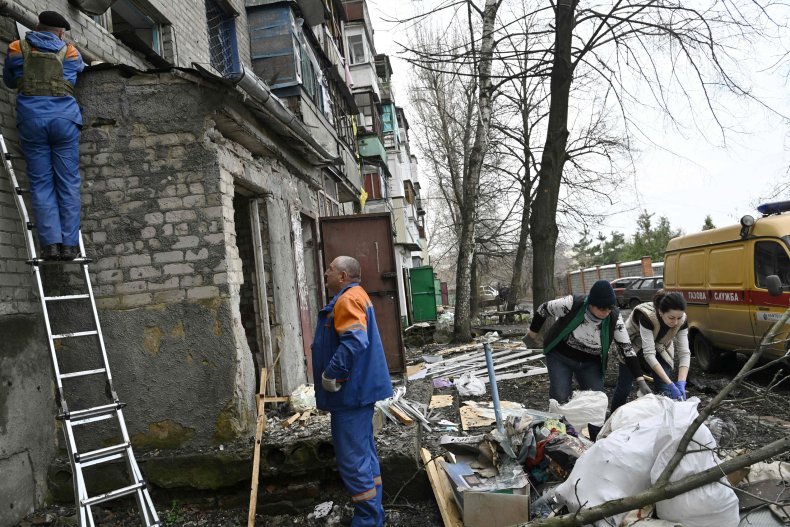Video Shows Russian Thermobaric Missiles Rain Down on Central Bakhmut
A video circulating online showed Russian TOS-1 thermobaric missiles fall down on central Bakhmut, the site of months-long intense battle between Russian and Ukrainian forces.
The satellite footage reposted on Twitter by Rob Lee, senior fellow at the Foreign Policy Research Institute, showed the moment the missiles hit the ground, causing destruction and massive flames. The amount and type of destruction—including whether civilians and infrastructure were hit—caused by the strike was unclear.
"Russian TOS-1A thermobaric MLRS strikes in central Bakhmut. Unfortunately, this a very effective weapon in urban terrain even against defenders in well-fortified positions," wrote Lee. The video was originally posted by a Telegram account user named Wagner Orchestra, who praised the attack, saying the missiles "grinded the positions of Ukrainian nationalists."
Russian TOS-1A thermobaric MLRS strikes in central Bakhmut. Unfortunately, this a very effective weapon in urban terrain even against defenders in well-fortified positions. https://t.co/3F0rzbHKKM pic.twitter.com/zyFiMACD6G
— Rob Lee (@RALee85) April 5, 2023
The TOS-1 or TOS-1A, also called Buratino, is a 30-barrel or 24-barrel multiple rocket launcher with thermobaric warheads that was designed to attack troops and forces in fortified positions as well as lightly armored vehicles and transports in open terrain.
Russia launched the TOS-1 last month in the Donbas region, with its forces being known to have long used them since the invasion of Ukraine began. Western defense ministries confirmed that the TOS-1A system was used in Ukraine within weeks of the war's start.
Bakhmut, which is located in eastern Ukraine in the Donetsk region and once a famous tourist destination before the war began, is now in ruins after months of shelling and artillery fire. The battle in the city has been the longest and bloodiest since Russia invaded Ukraine last year.
After the Russia-Ukraine war hit its one-year mark last month, Russian forces increased their attempts to take control of Bakhmut with the help of mercenaries from the Wagner Group, a private military company backed by Russian President Vladimir Putin.

The city is a strategic location for Moscow, which now controls only about half of the illegally annexed Donetsk region.
To take the remaining half, Russian forces have to go through Bakhmut, which is still seeing heavy counter-offensives by the Ukrainian military, despite losses on both sides. At the moment, the city remains under the control of the Ukrainian army, which continues to thwart Russian attacks.
"In the Bakhmut direction, the enemy continues storming actions of the city of Bakhmut," the General Staff of the Armed Forces of Ukraine posted last week on Facebook. "However, our defenders are bravely holding the city, fighting the numerous attacks of the enemy. During the day, the invaders carried out unsuccessful offensive actions in the area of Orihovo-Vasilivka Donetsk region."
Though Ukrainian forces continue to defend Bakhmut as they resist Russian offensives, Ukrainian President Volodymyr Zelensky suggested on Wednesday that he might order troops to withdraw in case they face Russian encirclement.
"For me, the most important is not to lose our soldiers and of course if there is a moment of even hotter events and the danger we could lose our personnel because of encirclement—of course the corresponding correct decisions will be taken by generals there," Zelensky said during a news conference in Poland alongside his Polish counterpart.
However, Zelensky still hinted that it's not yet time to retreat, confirming that Ukrainian troops are still holding on to Bakhmut and continue to be present inside the city.
"We are in Bakhmut and the enemy does not control it," said the Ukrainian president.
Newsweek reached out by email to the Ukrainian foreign affairs ministry for comment.








